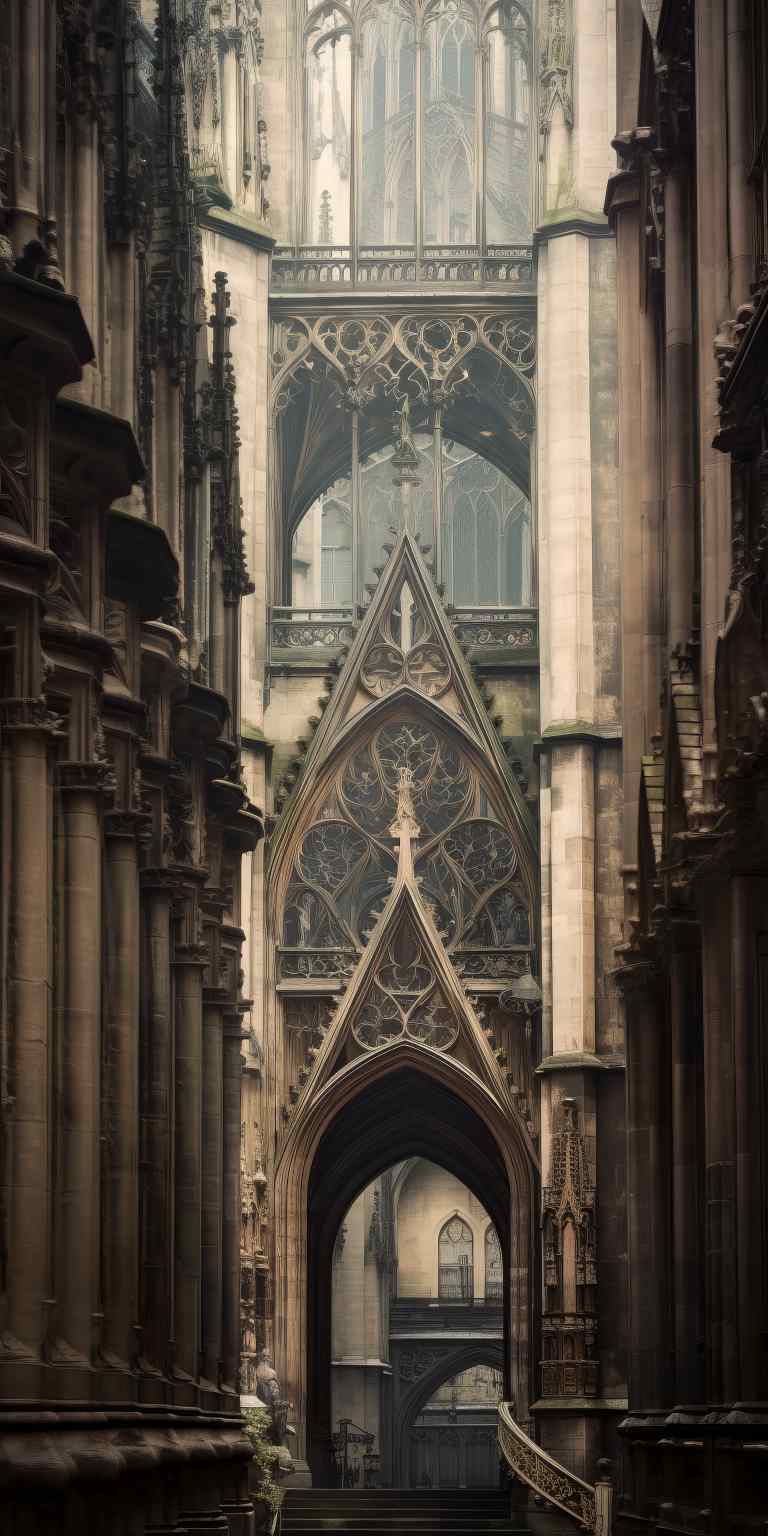Gothic Architecture
Gothic architecture originated in the mid-12th century in the Île-de-France region of northern France and gradually spread throughout Europe. It emerged as a response to the Romanesque style that dominated the preceding centuries. The term “Gothic” was initially used pejoratively during the Renaissance to describe this style, implying a sense of barbarism compared to the classical architecture of ancient Rome.
The Gothic era in architecture generally spanned from the 12th century through the 16th century. While the peak of Gothic architecture is often associated with the 13th century, it continued to evolve and influence construction well into the 14th and 15th centuries.
The key features of Gothic architecture include pointed arches, ribbed vaults, and flying buttresses. These elements allowed for greater height and expansive interior spaces in churches and cathedrals, creating a sense of grandeur and verticality. Other characteristic features include large windows with intricate tracery, often depicting biblical scenes or saints.


- November 21, 2023
- Dagmara Mach
Several factors contributed to the development of Gothic architecture:
Ecclesiastical Influence: Gothic architecture is closely associated with the construction of cathedrals and churches. The need for larger and more impressive religious structures to accommodate growing congregations and to reflect the power and wealth of the church played a significant role in the development of Gothic style.
Technological Innovations: Advances in construction techniques, such as the pointed arch and ribbed vault, allowed for greater stability and the ability to build higher structures. The flying buttress, an external arched support, helped counteract the outward thrust of the vaults and allowed for the construction of taller buildings with thinner walls.
Cultural and Economic Factors: The rise of medieval towns and the growth of trade and commerce led to increased prosperity in some regions. This, in turn, provided the financial resources needed for ambitious building projects. The Gothic style became a way for communities to express their wealth and devotion.
Theological and Symbolic Considerations: The Gothic style was also influenced by theological and symbolic concerns. The use of light, height, and intricate detailing was meant to inspire awe and convey a sense of the divine. The emphasis on verticality was seen as a symbolic connection between earth and heaven.
The Gothic style eventually evolved into various regional variations, including the English Perpendicular style, the German and Austrian Hallenkirche style, and the Spanish Flamboyant style.
Gothic architecture continued to influence subsequent architectural styles and has left a lasting impact on the cultural and artistic heritage of Europe.
12th Century
Began In The Early to Mid-1100s
- Years: The early Gothic period is often associated with the 12th century.
- Locations: The Île-de-France region in northern France, including the city of Paris, is considered the birthplace of Gothic architecture. The Basilica of Saint-Denis, near Paris, is often cited as the first Gothic building, and construction began around 1135.
13th Century
Continued through The 1200s
- Years: The 13th century saw the widespread adoption and refinement of Gothic architecture.
- Locations:
- Chartres Cathedral (begun in 1134, with major construction in the early 13th century) in France is a classic example of High Gothic architecture.
- Salisbury Cathedral in England (begun in 1220) is another notable example.
14th Century
And The 1300s
- Years: The 14th century continued to see the development of Gothic architecture, with regional variations.
- Locations:
- The Flamboyant Gothic style became prominent in Spain, as seen in Barcelona’s Cathedral of the Holy Cross and Saint Eulalia.
- The Hallenkirche style developed in Germany and Austria, characterized by a hall-like structure with a unified interior space.
15th Century
Through The Late Gothic 1400s
- Years: In the late 15th century, the Gothic style evolved into the Perpendicular style in England and the Manueline style in Portugal.
- Locations:
- King’s College Chapel in Cambridge, England (started in 1446), is an example of Perpendicular Gothic.
- The Monastery of Batalha in Portugal (constructed from 1386 to 1517) exhibits Manueline elements.
In some regions, the late 15th century saw a transition to Renaissance architecture, which marked a departure from many Gothic elements. However, it’s important to note that the timeline of architectural styles is not uniform across all regions, and the shift from Gothic to Renaissance was gradual and varied.
So, while the 1400s represent a period when the influence of Gothic architecture started to wane in certain areas, elements of the Gothic style persisted and continued to coexist with emerging architectural trends. The transition from one architectural style to another was a complex and gradual process that varied across different countries and regions.
15th Century
Through The Late Gothic 1400s
In some regions, the late 15th century saw a transition to Renaissance architecture, which marked a departure from many Gothic elements. However, it’s important to note that the timeline of architectural styles is not uniform across all regions, and the shift from Gothic to Renaissance was gradual and varied.
So, while the 1400s represent a period when the influence of Gothic architecture started to wane in certain areas, elements of the Gothic style persisted and continued to coexist with emerging architectural trends. The transition from one architectural style to another was a complex and gradual process that varied across different countries and regions.
16th Century
Ending in the 1500s
The Gothic era’s influence extended into the 16th century. Though the style began to wane, elements of Gothic architecture persisted alongside emerging Renaissance styles, and in some regions, Gothic features continued to be incorporated well into the 16th century.
The Renaissance, with its renewed interest in classical forms, began to gain prominence in the 15th century and gradually supplanted the Gothic style in certain areas. However, the transition was not uniform, and various Gothic architectural elements persisted in different regions and coexisted with Renaissance and other emerging styles.
In summary, while the 15th century is often associated with the shift toward Renaissance architecture, elements of Gothic architecture continued to be used and adapted into the 16th century, showcasing the complex and gradual nature of architectural developments during this period.
Alluringly Archaic Architectural Art
Vertical Emphasis:
- Allegory: The upward thrust of Gothic structures is often seen as a metaphor for spiritual ascent and the yearning for divine connection. The tall, pointed spires and soaring arches convey a sense of reaching towards the heavens.
Light and Darkness:
- Allegory: The use of light and shadow in Gothic architecture is sometimes interpreted as a representation of the struggle between good and evil, with light symbolizing divine illumination and darkness representing sin or ignorance. Stained glass windows, in particular, are thought to transmit divine light into the sacred space.
Gargoyles and Grotesques:
- Allegory: The presence of gargoyles and grotesques on Gothic buildings is often linked to the idea of warding off evil spirits. These sculpted figures on the exterior serve a practical purpose as water spouts but are also seen as symbolic protectors guarding the sacred space from malevolent forces.
Rose Windows:
- Allegory: The rose window, a common feature in Gothic cathedrals, is sometimes interpreted as a symbol of the divine order or the heavenly mandala. The intricate tracery and radiating patterns are thought to represent the harmony and balance of the cosmos.
Flying Buttresses:
- Allegory: Flying buttresses, which support the walls from the outside, are seen as both functional and symbolic. Structurally, they help distribute the weight of the massive walls, but allegorically, they represent the supportive arms of the Church reaching out to embrace the faithful.
Statuary and Sculptures:
- Allegory: The sculptures adorning Gothic cathedrals often depict biblical scenes, saints, and allegorical figures. These sculptures are thought to serve as didactic tools, conveying moral and religious lessons to the illiterate population of the time.
The development of Gothic architecture is primarily associated with medieval Europe, particularly during the High and Late Middle Ages (12th to 16th centuries). Gothic architecture emerged as a distinct style in the 12th century and reached its peak in the 13th to 15th centuries.
The Gothic arch is a key element in this architectural style and is characterized by its pointed shape. Gothic architecture is known for its use of pointed arches, ribbed vaults, and flying buttresses. These features allowed for greater height and light in buildings, creating a sense of verticality and grandeur.
The origins of the Gothic arch can be traced to the Romanesque architecture that preceded it. As builders and architects sought to improve upon the limitations of Romanesque structures, they experimented with different arch forms. The pointed arch, a distinctive feature of Gothic architecture, allowed for the distribution of weight more efficiently and facilitated the construction of taller and more spacious buildings.
While there was some cross-cultural exchange of architectural ideas during the medieval period, the Gothic arch and Gothic architecture, in general, are considered distinctively European in origin. The pointed arch, however, has been used in various cultures throughout history, including in Islamic architecture, where it was employed for both structural and decorative purposes. It’s important to note that while there may be some shared geometric principles in arch construction, the specific development and stylistic features of Gothic architecture were rooted in the European medieval context.
Gothic Arch vs. Islamic Arch
While both Gothic and Islamic architecture feature pointed arches, there are distinct differences in their design, purpose, and overall aesthetic. It’s important to note that Gothic architecture and Islamic architecture developed independently in different cultural and historical contexts. Here are some key differences between Gothic and Islamic pointed arches:
Structural Purpose:
Gothic Architecture: In Gothic architecture, the pointed arch served primarily as a structural element. It allowed for a more efficient distribution of weight, which, in turn, enabled the construction of taller and more spacious buildings. The pointed arch was a key innovation that contributed to the verticality and grandeur of Gothic cathedrals.
Islamic Architecture: In Islamic architecture, the pointed arch was also used for structural purposes, but it had different objectives. Islamic architecture, particularly during the Islamic Golden Age, aimed to create elaborate and aesthetically pleasing designs. The pointed arch in Islamic architecture was often part of a broader repertoire of geometric and decorative elements, contributing to the overall beauty of the structure.
Aesthetic and Decorative Elements:
Gothic Architecture: Gothic pointed arches were often paired with other distinctive features such as ribbed vaults, flying buttresses, and intricate tracery. The emphasis was on creating a sense of height, lightness, and spiritual awe. Decorative elements in Gothic architecture were integrated into the overall structure, and stained glass windows were common, allowing for the play of colored light.
Islamic Architecture: Islamic pointed arches were frequently part of a larger decorative scheme that included geometric patterns, arabesques, and calligraphy. Islamic architecture placed a strong emphasis on the use of ornamentation to create visually stunning interiors and exteriors. The pointed arch was often employed in combination with other design elements to achieve a harmonious and intricate appearance.
Cultural and Historical Context:
Gothic Architecture: Gothic architecture flourished in medieval Europe, especially during the 12th to 16th centuries. It was closely tied to the Christian religious and cultural context of the time, and Gothic cathedrals were often built as expressions of faith and the desire to glorify God.
Islamic Architecture: Islamic architecture has a rich and diverse history, with influences from various regions and cultures. The use of pointed arches in Islamic architecture can be observed in structures across the Islamic world, from Spain to the Middle East and beyond. The development of Islamic architecture was influenced by Islamic religious and cultural practices.
In summary, while both Gothic and Islamic architecture employed pointed arches, the specific design, function, and cultural meanings associated with these arches differed significantly due to the distinct historical, religious, and artistic contexts in which these architectural styles emerged.
Architecturally, the pointed arches in Gothic and Islamic architecture served different mathematical and structural purposes, reflecting the distinct design principles and goals of each architectural tradition.
Gothic Architecture: In Gothic architecture, the pointed arch was a key structural innovation that allowed for a more efficient distribution of weight. The pointed arch reduced the lateral thrust exerted by the vaults and allowed for the construction of taller and more expansive buildings. This architectural development was based on mathematical principles related to load-bearing and structural stability. The use of ribbed vaults and flying buttresses further complemented the structural integrity of Gothic cathedrals.
Islamic Architecture: In Islamic architecture, including the pointed arch within a broader geometric and decorative context was a way to achieve both structural stability and aesthetic beauty. Islamic architects were adept mathematicians and geometricians, and their designs often incorporated intricate geometric patterns, such as muqarnas (stalactite vaulting), tessellations, and calligraphy. The pointed arch, when combined with these geometric elements, contributed to the overall visual harmony of the structure. Mathematics played a crucial role in the precise and symmetrical execution of these decorative elements.
In summary, while both Gothic and Islamic pointed arches involved mathematical considerations, the emphasis and application of mathematical principles differed. Gothic architecture used the pointed arch primarily for structural efficiency in the vertical construction of large cathedrals, while Islamic architecture integrated the pointed arch into a broader decorative and geometric repertoire, showcasing the mathematical sophistication of Islamic design.
Tallest Gothic Era Buildings
Some of the tallest Gothic buildings in the world include:
- Ulm Minster (Ulm, Germany): The Ulm Minster is the tallest church in the world. Its spire reaches a height of approximately 161.5 meters (530 feet). Construction of the church began in the 14th century, and it was completed in the 19th century.
- Cologne Cathedral (Cologne, Germany): The Cologne Cathedral, also known as Kölner Dom, has the second-tallest spire of any Gothic cathedral. Its spires reach a height of about 157 meters (515 feet). Construction began in the 13th century, and the cathedral was completed in the 19th century.
- Strasbourg Cathedral (Strasbourg, France): The Strasbourg Cathedral has a spire that reaches a height of around 142 meters (466 feet). Construction started in the 12th century and continued for several centuries.
- St. Nikolai, Hamburg (Hamburg, Germany): While no longer a functioning church, the spire of St. Nikolai in Hamburg, Germany, stands at approximately 147 meters (482 feet). The church was heavily damaged during World War II, and only the spire remains as a memorial.
- Beauvais Cathedral (Beauvais, France): Beauvais Cathedral has the tallest choir (the eastern part of the church) among Gothic cathedrals, with a height of about 47.5 meters (156 feet). The construction of Beauvais Cathedral faced several structural challenges, and the intended completion was never realized.

